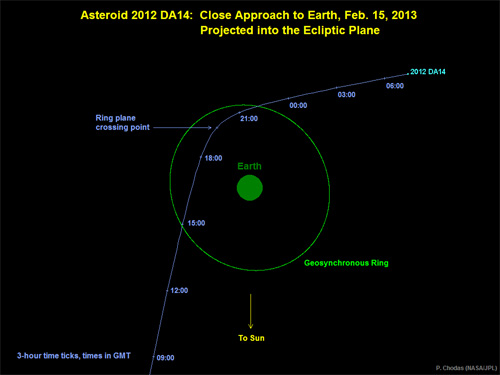
Large near-Earth asteroid makes unprecedented close approach on February 15thBy Mary Kauffman
February 12, 2013
Asteroid 2012 DA 14 is traveling at about 17,450 miles per hour or 4.8 miles per second relative to Earth. The flyby of asteroid 2012 DA14 is the closest ever predicted Earth approach for an object this large. Asteroid 2012 DA14 will not impact Earth, but if another asteroid of a size similar to that of 2012 DA14 (about 150 feet across) were to impact Earth, it would release approximately 2.5 megatons of energy in the atmosphere and would be expected to cause regional devastation.
The flyby of asteroid 2012 DA14 on Feb. 15, 2013, will be the closest known approach to Earth for an object its size. An object the size of asteroid 2012 DA14, actually impacted the Earth on June 30, 1908 -- the so-called "Tunguska event." An object about 30 or 40 meters came down in the Earth's atmosphere and exploded leveling trees for 820 square miles in Russia. Asteroid 2012 DA14 will be coming from the south to the north and the asteriod actually gets to within 17,200 miles of the Earth's surface. It will pass interior to the geosynchronous satellites and the GPS satellites, but, according to NASA, there's really no chance of the asteroid hitting the Earth and very little change it will hit a satellite. It's going to be brighter than most asteroids but it still is not going to be a naked eye object. To view the asteroid, you will need a good pair of binoculars, or even better, a moderately powered telescope. During the closest approach, and dependant on local weather, the asteroid will be visible from parts of Europe, Africa and Asia. The asteroid will appear to be moving relatively quickly as it crosses the sky from the south to the north. NASA's Near-Earth Object Program Office can accurately predict the asteroid's path with the observations obtained, and it is therefore known that there is no chance that the asteroid might be on a collision course with Earth. Nevertheless, the flyby will provide a unique opportunity for researchers to study a near-Earth object up close.
Graphic depicts the trajectory of asteroid 2012 DA14 on Feb 15, 2013. In this view, we are looking down from above Earth's north pole. Twently years ago, this object probably wouldn't have been found. But now NASA is observing the skies nightly and picking up these objects and tracks them for a hundred years into the future to see if any of them make interesting close Earth approaches. Not only because of the threat issue but because these objects are important for science, they're important for future resources, as well as threats. Scientists at NASA's Near-Earth Object Program Office in Pasadena, Calif. estimate that an asteroid the size of 2012 DA14 flies this close to the earth every 40 years on average and that one will impact Earth, on average, about once in every 1,200 years. Asteroid 2012 DA14's will be within the Earth/moon system for about 33 hours. Its orbit will bring it within the Earth/moon system (approach within one lunar distance, 237,000 miles of the Earth) on Feb. 15 at about 8 p.m. Alaska time on Thursday, Feb. 14). The asteroid will exit the Earth/moon system on Feb. 16 at about 5 a.m. Alaska time. Asteroid 2012 DA14 was discovered by the La Sagra Sky Survey operated by the Astronomical Observatory of Mallorca in Spain on Feb. 23, 2012.
Edited by Mary Kauffman, SitNews
Source of News:
E-mail your news &
photos to editor@sitnews.us
|
||
